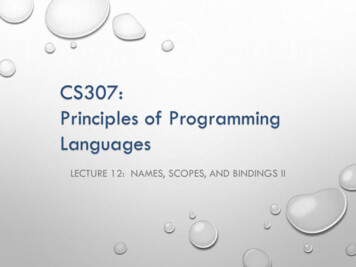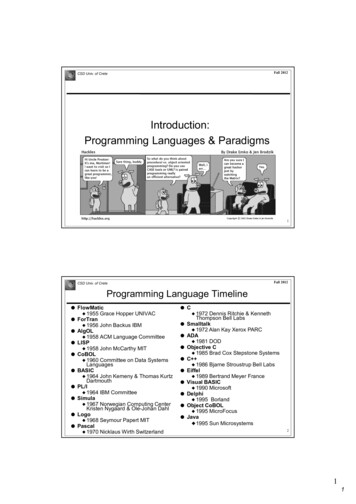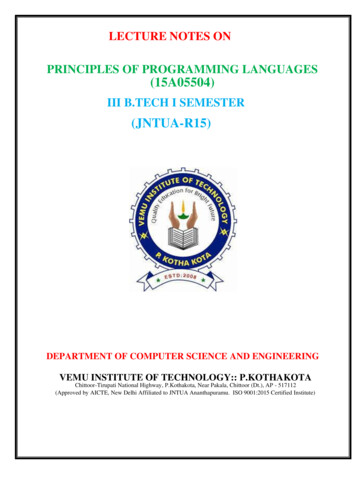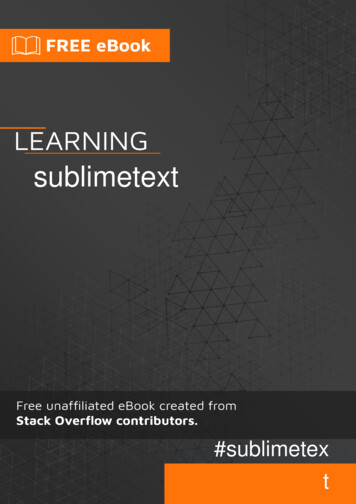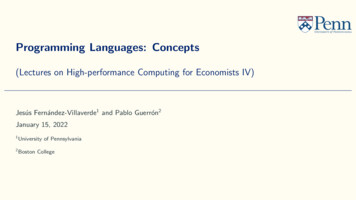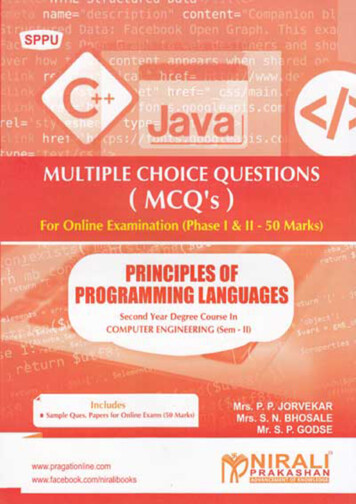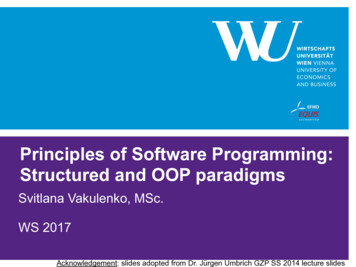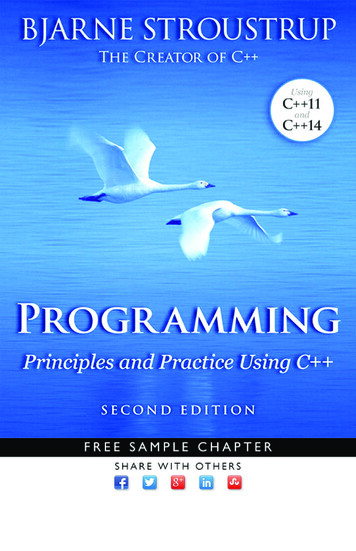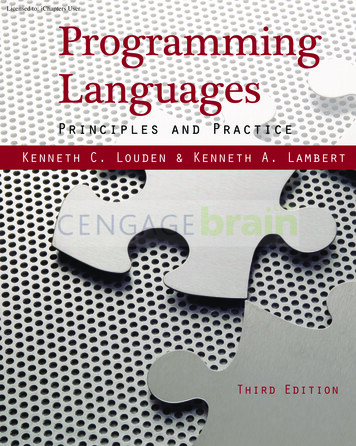
Transcription
Licensed to: iChapters User
Licensed to: iChapters UserProgramming Languages: Principlesand Practice, Third EditionKenneth C. Louden and Kenneth A. LambertExecutive Editor: Marie LeeAcquisitions Editor: Brandi ShailerSenior Product Manager: Alyssa PrattDevelopment Editor: Ann ShafferEditorial Assistant: Jacqueline LacaireAssociate Marketing Manager:Shanna SheltonContent Project Manager: Jennifer FeltriArt Director: Faith Brosnan 2012 Course Technology, Cengage LearningALL RIGHTS RESERVED. No part of this work covered by the copyrightherein may be reproduced, transmitted, stored or used in any form or byany means graphic, electronic, or mechanical, including but not limited tophotocopying, recording, scanning, digitizing, taping, Web distribution,information networks, or information storage and retrieval systems, exceptas permitted under Section 107 or 108 of the 1976 United States CopyrightAct, without the prior written permission of the publisher.For product information and technology assistance, contact us atCengage Learning Customer & Sales Support, 1-800-354-9706For permission to use material from this text or product, submit allrequests online at www.cengage.com/permissionsFurther permissions questions can be emailed topermissionrequest@cengage.comPrint Buyer: Julio EsperasCover Designer: Saizon DesignLibrary of Congress Control Number: 2010939435Cover Photo: Ocean/CorbisCompositor: IntegraCopyeditor: Foxxe EditorialProofreader: Christine ClarkIndexer: Sharon HilgenbergISBN-13: 978-1-111-52941-3ISBN-10: 1-111-52941-8Course Technology20 Channel Center StreetBoston, MA 02210USACourse Technology, a part of Cengage Learning, reserves the right to revisethis publication and make changes from time to time in its content withoutnotice.The programs in this book are for instructional purposes only.They have been tested with care, but are not guaranteed for any particularintent beyond educational purposes. The author and the publisher do notoffer any warranties or representations, nor do they accept any liabilitieswith respect to the programs.Cengage Learning is a leading provider of customized learning solutionswith office locations around the globe, including Singapore, the UnitedKingdom, Australia, Mexico, Brazil, and Japan. Locate your local office at:www.cengage.com/globalCengage Learning products are represented in Canada byNelson Education, Ltd.To learn more about Course Technology, visitwww.cengage.com/coursetechnologyPurchase any of our products at your local college store or at our preferredonline store www.cengagebrain.comPrinted in the United States of America1 2 3 4 5 6 7 17 16 15 14 13 12 11Copyright 2011 Cengage Learning. All Rights Reserved. May not be copied, scanned, or duplicated, in whole or in part. Due to electronic rights, some third party content may be suppressed from the eBook and/or eChapter(s).Editorial review has deemed that any suppressed content does not materially affect the overall learning experience. Cengage Learning reserves the right to remove additional content at any time if subsequent rights restrictions require it.C7729 fm.indd ii03/01/11 10:51 AM
Licensed to: iChapters UserC HAPT ER1Introduction1.1The Origins of Programming Languages31.2Abstractions in Programming Languages81.3Computational Paradigms151.4Language Definition161.5Language Translation181.6The Future of Programming Languages191Copyright 2011 Cengage Learning. All Rights Reserved. May not be copied, scanned, or duplicated, in whole or in part. Due to electronic rights, some third party content may be suppressed from the eBook and/or eChapter(s).Editorial review has deemed that any suppressed content does not materially affect the overall learning experience. Cengage Learning reserves the right to remove additional content at any time if subsequent rights restrictions require it.C7729 ch01.indd 103/01/11 8:54 AM
Licensed to: iChapters UserCHAPTER1 IntroductionHow we communicate influences how we think, and vice versa. Similarly, how we program computersinfluences how we think about computation, and vice versa. Over the last several decades, programmershave, collectively, accumulated a great deal of experience in the design and use of programminglanguages. Although we still don’t completely understand all aspects of the design of programminglanguages, the basic principles and concepts now belong to the fundamental body of knowledge ofcomputer science. A study of these principles is as essential to the programmer and computer scientistas the knowledge of a particular programming language such as C or Java. Without this knowledge it isimpossible to gain the needed perspective and insight into the effect that programming languages andtheir design have on the way that we solve problems with computers and the ways that we think aboutcomputers and computation.It is the goal of this text to introduce the major principles and concepts underlying programminglanguages. Although this book does not give a survey of programming languages, specific languagesare used as examples and illustrations of major concepts. These languages include C, C , Ada,Java, Python, Haskell, Scheme, and Prolog, among others. You do not need to be familiar with all ofthese languages in order to understand the language concepts being illustrated. However, you shouldbe experienced with at least one programming language and have some general knowledge of datastructures, algorithms, and computational processes.In this chapter, we will introduce the basic notions of programming languages and outline someof the basic concepts. Figure 1.1 shows a rough timeline for the creation of several of the majorprogramming languages that appear in our discussion. Note that some of the languages are embedded ina family tree, indicating their evolutionary relationships.Copyright 2011 Cengage Learning. All Rights Reserved. May not be copied, scanned, or duplicated, in whole or in part. Due to electronic rights, some third party content may be suppressed from the eBook and/or eChapter(s).Editorial review has deemed that any suppressed content does not materially affect the overall learning experience. Cengage Learning reserves the right to remove additional content at any time if subsequent rights restrictions require it.C7729 ch01.indd 203/01/11 8:54 AM
Licensed to: iChapters User1.1 The Origins of Programming SimulaPL/IModula 2PascalLispRubyC CALGOL3JavaModula 3AdaSchemeCommon LispCOBOLFORTRANAssemblylanguage1950Figure 1.1196019701980199020002010A programming language timeline1.1 The Origins of Programming LanguagesA definition often advanced for a programming language is “a notation for communicating to a computerwhat we want it to do,” but this definition is inadequate. Before the middle of the 1940s, computer operators“hardwired” their programs. That is, they set switches to adjust the internal wiring of a computer to performthe requested tasks. This effectively communicated to the computer what computations were desired, butprogramming, if it could be called that, consisted of the expensive and error-prone activity of taking downthe hardware to restructure it. This section examines the origins and emergence of programming languages,which allowed computer users to solve problems without having to become hardware engineers.1.1.1 Machine Language and the First Stored ProgramsA major advance in computer design occurred in the late 1940s, when John von Neumann had theidea that a computer should be permanently hardwired with a small set of general-purpose operations[Schneider and Gersting, 2010]. The operator could then input into the computer a series of binary codesthat would organize the basic hardware operations to solve more-specific problems. Instead of turning offthe computer to reconfigure its circuits, the operator could flip switches to enter these codes, expressedin machine language, into computer memory. At this point, computer operators became the first trueprogrammers, who developed software—the machine code—to solve problems with computers.Figure 1.2 shows the code for a short machine language program for the LC-3 machine architecture[Patt and Patel, 2003].Copyright 2011 Cengage Learning. All Rights Reserved. May not be copied, scanned, or duplicated, in whole or in part. Due to electronic rights, some third party content may be suppressed from the eBook and/or eChapter(s).Editorial review has deemed that any suppressed content does not materially affect the overall learning experience. Cengage Learning reserves the right to remove additional content at any time if subsequent rights restrictions require it.C7729 ch01.indd 303/01/11 8:54 AM
Licensed to: iChapters User4CHAPTER 1 0000010100000000000001100000000000000000Figure 1.2A machine language programIn this program, each line of code contains 16 bits or binary digits. A line of 16 bits represents either asingle machine language instruction or a single data value. The last three lines of code happen to represent data values—the integers 5, 6, and 0—using 16-bit twos complement notation. The first five linesof code represent program instructions. Program execution begins with the first line of code, which isfetched from memory, decoded (interpreted), and executed. Control then moves to the next line of code,and the process is repeated, until a special halt instruction is reached.To decode or interpret an instruction, the programmer (and the hardware) must recognize the first4 bits of the line of code as an opcode, which indicates the type of operation to be performed. Theremaining 12 bits contain codes for the instruction’s operands. The operand codes are either the numbers of machine registers or relate to the addresses of other data or instructions stored in memory. Forexample, the first instruction, 0010001000000100, contains an opcode and codes for two operands.The opcode 0010 says, “copy a number from a memory location to a machine register” (machine registers are high-speed memory cells that hold data for arithmetic and logic computations). The numberof the register, 001, is found in the next 3 bits. The remaining 9 bits represent an integer offset from theaddress of the next instruction. During instruction execution, the machine adds this integer offset to thenext instruction’s address to obtain the address of the current instruction’s second operand (rememberthat both instructions and data are stored in memory). In this case, the machine adds the binary number 100 (4 in binary) to the number 1 (the address of the next instruction) to obtain the binary number101 (5 in binary), which is the address of the sixth line of code. The bits in this line of code, in turn,represent the number to be copied into the register.We said earlier that execution stops when a halt instruction is reached. In our program example, thatinstruction is the fifth line of code, 1111000000100101. The halt instruction prevents the machine fromcontinuing to execute the lines of code below it, which represent data values rather than instructions forthe program.As you might expect, machine language programming is not for the meek. Despite the improvementon the earlier method of reconfiguring the hardware, programmers were still faced with the tedious anderror-prone tasks of manually translating their designs for solutions to binary machine code and loadingthis code into computer memory.1.1.2 Assembly Language, Symbolic Codes, and Software ToolsThe early programmers realized that it would be a tremendous help to use mnemonic symbols forthe instruction codes and memory locations, so they developed assembly language for this purpose.Copyright 2011 Cengage Learning. All Rights Reserved. May not be copied, scanned, or duplicated, in whole or in part. Due to electronic rights, some third party content may be suppressed from the eBook and/or eChapter(s).Editorial review has deemed that any suppressed content does not materially affect the overall learning experience. Cengage Learning reserves the right to remove additional content at any time if subsequent rights restrictions require it.C7729 ch01.indd 403/01/11 8:54 AM
Licensed to: iChapters User1.1 The Origins of Programming Languages5This type of language relies on software tools to automate some of the tasks of the programmer.A program called an assembler translates the symbolic assembly language code to binary machinecode. For example, let’s say that the first instruction in the program of Figure 1.2 reads:LD R1, FIRSTin assembly language. The mnemonic symbol LD (short for “load”) translates to the binary opcode 0010seen in line 1 of Figure 1.2. The symbols R1 and FIRST translate to the register number 001 and the dataaddress offset 000000100, respectively. After translation, another program, called a loader, automatically loads the machine code for this instruction into computer memory.Programmers also used a pair of new input devices—a keypunch machine to type their assemblylanguage codes and a card reader to read the resulting punched cards into memory for the assembler.These two devices were the forerunners of today’s software text editors. These new hardware and software tools made it much easier for programmers to develop and modify their programs. For example, toinsert a new line of code between two existing lines of code, the programmer now could put a new cardinto the keypunch, enter the code, and insert the card into the stack of cards at the appropriate position.The assembler and loader would then update all of the address references in the program, a task thatmachine language programmers once had to perform manually. Moreover, the assembler was able tocatch some errors, such as incorrect instruction formats and incorrect address calculations, which couldnot be discovered until run time in the pre-assembler era.Figure 1.3 shows the machine language program of Figure 1.2 after it has been “disassembled” intothe LC-3 assembly language. It is now possible for a human being to read what the program does. Theprogram adds the numbers in the variables FIRST and SECOND and stores the result in the variable SUM. Inthis code, the symbolic labels FIRST, SECOND, and SUM name memory locations containing data, the labelsR1, R2, and R3 name machine registers, and the labels LD, ADD, ST, and HALT name opcodes. The programis also commented (the text following each semicolon) to clarify what it does for the human reader.ORIG x3000LD R1, FIRSTLD R2, SECONDADD R3, R2, R1ST R3, SUMHALTFIRST .FILL #5SECOND .FILL #6SUM.BLKW #1.ENDFigure 1.3;;;;;;;;;;;Address (in hexadecimal) of the first instructionCopy the number in memory location FIRST to register R1Copy the number in memory location SECOND to register R2Add the numbers in R1 and R2 and place the sum inregister R3Copy the number in R3 to memory location SUMHalt the programLocation FIRST contains decimal 5Location SECOND contains decimal 6Location SUM (contains 0 by default)End of programAn assembly language program that adds two numbersAlthough the use of mnemonic symbols represents an advance on binary machine codes, assemblylanguage still has some shortcomings. The assembly language code in Figure 1.3 allows the programmerto represent the abstract mathematical idea, “Let FIRST be 5, SECOND be 6, and SUM be FIRST SECOND” as a sequence of human-readable machine instructions. Many of these instructions must moveCopyright 2011 Cengage Learning. All Rights Reserved. May not be copied, scanned, or duplicated, in whole or in part. Due to electronic rights, some third party content may be suppressed from the eBook and/or eChapter(s).Editorial review has deemed that any suppressed content does not materially affect the overall learning experience. Cengage Learning reserves the right to remove additional content at any time if subsequent rights restrictions require it.C7729 ch01.indd 503/01/11 8:54 AM
Licensed to: iChapters User6CHAPTER 1 Introductiondata from variables/memory locations to machine registers and back again, however; assembly languagelacks the more powerful abstraction capability of conventional mathematical notation. An abstractionis a notation or way of expressing ideas that makes them concise, simple, and easy for the human mindto grasp. The philosopher/mathematician A. N. Whitehead emphasized the power of abstract notationin 1911: “By relieving the brain of all unnecessary work, a good notation sets it free to concentrate onmore advanced problems. . . . Civilization advances by extending the number of important operationswhich we can perform without thinking about them.” In the case of assembly language, the programmermust still do the hard work of translating the abstract ideas of a problem domain to the concrete andmachine-dependent notation of a program.A second major shortcoming of assembly language is due to the fact that each particular type ofcomputer hardware architecture has its own machine language instruction set, and thus requires its owndialect of assembly language. Therefore, any assembly language program has to be rewritten to port it todifferent types of machines.The first assembly languages appeared in the 1950s. They are still used today, whenever very lowlevel system tools must be written, or whenever code segments must be optimized by hand for efficiency.You will likely have exposure to assembly language programming if you take a course in computer organization, where the concepts and principles of machine architecture are explored.1.1.3 FORTRAN and Algebraic NotationUnlike assembly language, high-level languages, such as C, Java, and Python, support notations closerto the abstractions, such as algebraic expressions, used in mathematics and science. For example, thefollowing code segment in C or Java is equivalent to the assembly language program for adding twonumbers shown earlier:int first 5;int second 6;int sum first second;One of the precursors of these high-level languages was FORTRAN, an acronym for FORmulaTRANslation language. John Backus developed FORTRAN in the early 1950s for a particular type ofIBM computer. In some respects, early FORTRAN code was similar to assembly language. It reflectedthe architecture of a particular type of machine and lacked the structured control statements and datastructures of later high-level languages. However, FORTRAN did appeal to scientists and engineers,who enjoyed its support for algebraic notation and floating-point numbers. The language has undergonenumerous revisions in the last few decades, and now supports many of the features that are associatedwith other languages descending from its original version.1.1.4 The ALGOL Family: Structured Abstractionsand Machine IndependenceSoon after FORTRAN was introduced, programmers realized that languages with still higher levels ofabstraction would improve their ability to write concise, understandable instructions. Moreover, theywished to write these high-level instructions for different machine architectures with no changes. In thelate 1950s, an international committee of computer scientists (which included John Backus) agreed onCopyright 2011 Cengage Learning. All Rights Reserved. May not be copied, scanned, or duplicated, in whole or in part. Due to electronic rights, some third party content may be suppressed from the eBook and/or eChapter(s).Editorial review has deemed that any suppressed content does not materially affect the overall learning experience. Cengage Learning reserves the right to remove additional content at any time if subsequent rights restrictions require it.C7729 ch01.indd 603/01/11 8:54 AM
Licensed to: iChapters User1.1 The Origins of Programming Languages7a definition of a new language whose purpose was to satisfy both of these requirements. This languagebecame ALGOL (an acronym for ALGOrithmic Language). Its first incarnation, ALGOL-60, was releasedin 1960.ALGOL provided first of all a standard notation for computer scientists to publish algorithms in journals. As such, the language included notations for structured control statements for sequencing (begin-endblocks), loops (the for loop), and selection (the if and if-else statements). These types of statementshave appeared in more or less the same form in every high-level language since. Likewise, elegant notationsfor expressing data of different numeric types (integer and float) as well as the array data structure wereavailable. Finally, support for procedures, including recursive procedures, was provided. These structuredabstractions, and more, are explored in detail later in this chapter and in later chapters of this book.The ALGOL committee also achieved machine independence for program execution on computersby requiring that each type of hardware provide an ALGOL compiler. This program translated standardALGOL programs to the machine code of a particular machine.ALGOL was one of the first programming languages to receive a formal specification or definition.Its published report included a grammar that defined its features, both for the programmer who used itand for the compiler writer who translated it.A very large number of high-level languages are descended from ALGOL. Niklaus Wirth createdone of the early ones, Pascal, as a language for teaching programming in the 1970s. Another, Ada, wasdeveloped in the 1980s as a language for embedded applications for the U.S. Department of Defense. Thedesigners of ALGOL’s descendants typically added features for further structuring data and large units ofcode, as well as support for controlling access to these resources within a large program.1.1.5 Computation Without the von Neumann ArchitectureAlthough programs written in high-level languages became independent of particular makes and modelsof computers, these languages still echoed, at a higher level of abstraction, the underlying architectureof the von Neumann model of a machine. This model consists of an area of memory where both programs and data are stored and a separate central processing unit that sequentially executes instructionsfetched from memory. Most modern programming languages still retain the flavor of this single processormodel of computation. For the first five decades of computing (from 1950 to 2000), the improvements inprocessor speed (as expressed in Moore’s Law, which states that hardware speeds increase by a factor of2 every 18 months) and the increasing abstraction in programming languages supported the conversionof the industrial age into the information age. However, this steady progress in language abstraction andhardware performance eventually ran into separate roadblocks.On the hardware side, engineers began, around the year 2005, to reach the limits of the improvements predicted by Moore’s Law. Over the years, they had increased processor performance byshortening the distance between processor components, but as components were packed more tightlyonto a processor chip, the amount of heat generated during execution increased. Engineers mitigated thisproblem by factoring some computations, such as floating-point arithmetic and graphics/image processing, out to dedicated processors, such as the math coprocessor introduced in the 1980s and the graphicsprocessor first released in the 1990s. Within the last few years, most desktop and laptop computers havebeen built with multicore architectures. A multicore architecture divides the central processing unit(CPU) into two or more general-purpose processors, each with its own specialized memory, as well asmemory that is shared among them. Although each “core” in a multicore processor is slower than theCopyright 2011 Cengage Learning. All Rights Reserved. May not be copied, scanned, or duplicated, in whole or in part. Due to electronic rights, some third party content may be suppressed from the eBook and/or eChapter(s).Editorial review has deemed that any suppressed content does not materially affect the overall learning experience. Cengage Learning reserves the right to remove additional content at any time if subsequent rights restrictions require it.C7729 ch01.indd 703/01/11 8:54 AM
Licensed to: iChapters User8CHAPTER 1 IntroductionCPU of a traditional single-processor machine, their collaboration to carry out computations in parallelcan potentially break the roadblock presented by the limits of Moore’s Law.On the language side, despite the efforts of designers to provide higher levels of abstraction forvon Neumann computing, two problems remained. First, the model of computation, which relied uponchanges to the values of variables, continued to make very large programs difficult to debug and correct.Second, the single-processor model of computation, which assumes a sequence of instructions thatshare a single processor and memory space, cannot be easily mapped to the new hardware architectures,whose multiple CPUs execute in parallel. The solution to these problems is the insight that programminglanguages need not be based on any particular model of hardware, but need only support models ofcomputation suitable for various styles of problem solving.The mathematician Alonzo Church developed one such model of computation in the late 1930s. Thismodel, called the lambda calculus, was based on the theory of recursive functions. In the late 1950s,John McCarthy, a computer scientist at M.I.T. and later at Stanford, created the programming languageLisp to construct programs using the functional model of computation. Although a Lisp interpreter translated Lisp code to machine code that actually ran on a von Neumann machine (the only kind of machineavailable at that time), there was nothing about the Lisp notation that entailed a von Neumann model ofcomputation. We shall explore how this is the case in detail in later chapters. Meanwhile, researchershave developed languages modeled on other non–von Neumann models of computing. One such modelis formal logic with automatic theorem proving. Another involves the interaction of objects via messagepassing. We examine these models of computing, which lend themselves to parallel processing, and thelanguages that implement them in later chapters.1.2 Abstractions in Programming LanguagesWe have noted the essential role that abstraction plays in making programs easier for people to read.In this section, we briefly describe common abstractions that programming languages provide toexpress computation and give an indication of where they are studied in more detail in subsequentchapters. Programming language abstractions fall into two general categories: data abstraction andcontrol abstraction. Data abstractions simplify for human users the behavior and attributes of data, suchas numbers, character strings, and search trees. Control abstractions simplify properties of the transferof control, that is, the modification of the execution path of a program based on the situation at hand.Examples of control abstractions are loops, conditional statements, and procedure calls.Abstractions also are categorized in terms of levels, which can be viewed as measures of the amountof information contained (and hidden) in the abstraction. Basic abstractions collect the most localizedmachine information. Structured abstractions collect intermediate information about the structure of aprogram. Unit abstractions collect large-scale information in a program.In the following sections, we classify common abstractions according to these levels of abstraction,for both data abstraction and control abstraction.1.2.1 Data: Basic AbstractionsBasic data abstractions in programming languages hide the internal representation of common data valuesin a computer. For example, integer data values are often stored in a computer using a two’s complementrepresentation. On some machines, the integer value -64 is an abstraction of the 16-bit twos complementCopyright 2011 Cengage Learning. All Rights Reserved. May not be copied, scanned, or duplicated, in whole or in part. Due to electronic rights, some third party content may be suppressed from the eBook and/or eChapter(s).Editorial review has deemed that any suppressed content does not materially affect the overall learning experience. Cengage Learning reserves the right to remove additional content at any time if subsequent rights restrictions require it.C7729 ch01.indd 803/01/11 8:54 AM
Licensed to: iChapters User1.2 Abstractions in Programming Languages9value 1111111111000000. Similarly, a real or floating-point data value is usually provided, which hidesthe IEEE single- or double-precision machine representation of such numbers. These values are alsocalled “primitive” or “atomic,” because the programmer cannot normally access the component parts orbits of their internal representation [Patt and Patel, 2003].Another basic data abstraction is the use of symbolic names to hide locations in computer memorythat contain data values. Such named locations are called variables. The kind of data value is also given aname and is called a data type. Data types of basic data values are usually given names that are variations of their corresponding mathematical values, such as int, double, and float. Variables are givennames and data types using a declaration, such as the Pascal:var x : integer;or the equivalent C declaration:int x;In this example, x is established as the name of a variable and is given the data type integer.Finally, standard operations, such as addition and multiplication, on basic data types are alsoprovided. Data types are studied in Chapter 8 and declarations in Chapter 7.1.2.2 Data: Structured AbstractionsThe data structure is the principal method for collecting related data values into a single unit. Forexample, an employee record may consist of a name, address, phone number, and salary, each of whichmay be a different data type,
It is the goal of this text to introduce the major principles and concepts underlying programming languages. Although this book does not give a survey of programming languages, specific languages are used as examples and illustrations of major concepts. These languages include C, C , Ada,
